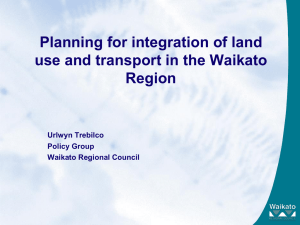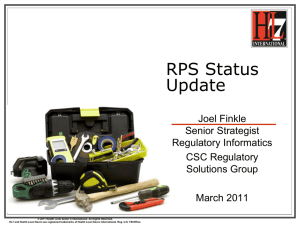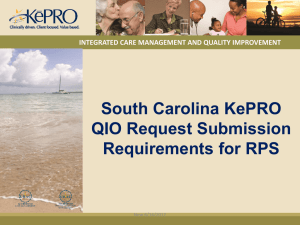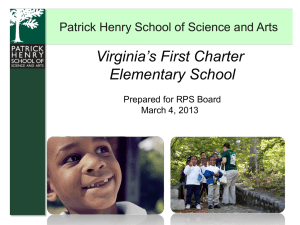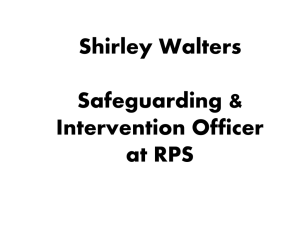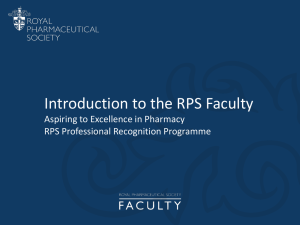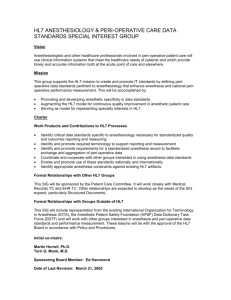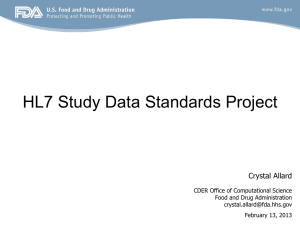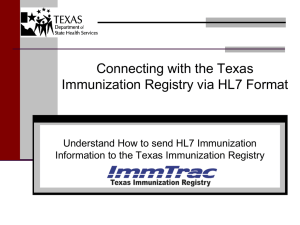HL7 Project Charter
advertisement
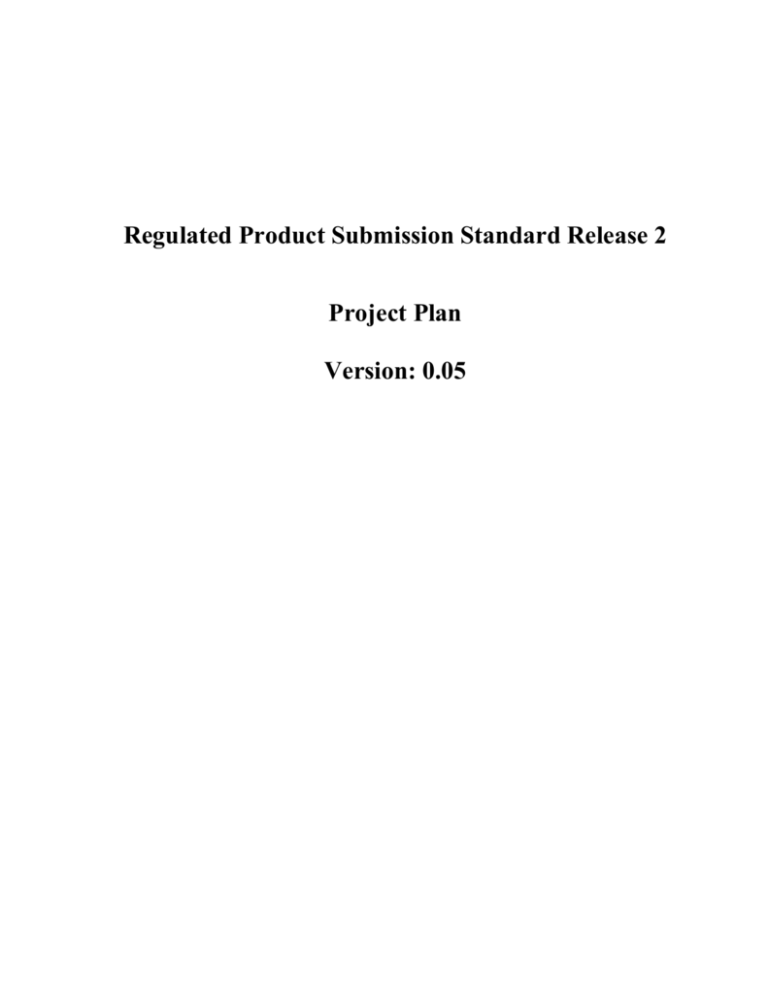
Regulated Product Submission Standard Release 2 Project Plan Version: 0.05 TABLE OF CONTENTS 1.0 Project Overview / Description............................................................................................... 2 1.1 Project Development Methodology .................................................................................... 2 2.0 Objectives, Scope and Success Criteria ............................................................................... 3 2.1 Project Objectives .............................................................................................................. 3 2.2 Project Scope ..................................................................................................................... 3 2.2.1 General Scope Description ......................................................................................... 3 2.2.2 In Scope ...................................................................................................................... 3 2.2.3 Out of Scope ............................................................................................................... 4 2.3 Completion and Success Criteria: ...................................................................................... 4 3.0 Project Deliverables ............................................................................................................... 5 4.0 Project Stakeholders, Participants, Governance and Structure ............................................ 5 4.1 Governance ........................................................................................................................ 5 4.2 Project Management Team ................................................................................................ 6 4.3 Advisory Committee ........................................................................................................... 6 4.4 RCRIM RPS 2 Workgroup ................................................................................................. 7 4.5 Domain Analysis Team ...................................................................................................... 7 4.6 Specification Design Team (HL7 Development Team) ...................................................... 9 4.7 Testing Team ..................................................................................................................... 9 5.0 Project Risks ........................................................................................................................12 6.0 Communications ..................................................................................................................12 7.0 Project Milestones ...............................................................................................................13 8.0 Workgroup Engagement ......................................................................................................14 9.0 Project Controls ...................................................................................................................14 9.1.1 Project schedule (high level work plan) ....................................................................14 9.1.2 Project status reporting .............................................................................................14 9.1.3 Project Change Management ...................................................................................15 9.1.4 Project Issue Management .......................................................................................15 Revision History File Name Version Date Author Description 0.01 200802-28 Peggy Leizear, Jason Rock Initial draft 0.02 200805-05 Peggy Leizear, Jason Rock, Bill Rosen, Mary Ann Slack, Armando Oliva Initial comments and edits completed 0.03 200808-13 Peggy Leizear, RCRIM Workgroup Updated to include new information in the plan utilizing the original project charter Peggy Leizear, RCRIM Workgroup Updated to include comments from workgroup and to include project schedule, risks, links to documents on the HL7 wiki Peggy Leizear, Dirk Beth Updated to include full list of testing team participants including contact information. 0.04 200809-12 0.05 200811-25 -1- 1.0 Project Overview / Description The HL7 V3 Regulated Product Submission (RPS) Standard Release 1 was approved as a normative standard in May 2008. With the release of this standard an applicant company was able to create and submit an RPS message with the following basic functionality: Document lifecycle, reuse of documents across submission, submission management across the lifecycle, allowance for product differences in content. The standard was created primarily by participants in the US, particularly people with medical devices and human pharmaceuticals expertise. The RPS Release 2 Project intends to enhance the existing RPS Release 1 standard by adding new functionality. The initial development of the existing RPS Release 1 has been driven by commitments in the PDUFA IV agreements. The development of the standard for global use is also considered with the expectation that the ICH requirements for the next major version of the electronic Common Technical Document (eCTD) will also be brought into the project development, though it is recognized that this had not been agreed at the time of the project kickoff. However, it also expected that individual national agencies may choose to participate, along with representatives from the pharmaceutical and healthcare industries in other regions. The ultimate goal of the RPS Project is to deliver a global standard applicable to all regulated product submission types within the healthcare arena. 1.1 Project Development Methodology RPS Release 2 will follow standard HL7 development methodology and use an iterative approach to the development of the final standard. In this approach the development is broken down into Lifecycles and Iterations, time segments during which a controlled set of functionalities will be added to the current standard. The initial lifecycle will address requirements to enhance the functionality for preparing and submitting to the US FDA, specifically those related to the new FDA PDUFA IV commitments. The requirements of other regions will also be considered in this lifecycle, depending on the input from representatives from these regions during the lifecycle. The ICH eCTD requirements may be included during this lifecycle, depending on the timely delivery of the requirements. A second lifecycle may be necessary to complete the development of the RPS Release 2 standard. Alternatively, the second lifecycle may be necessary to fully meet the requirements of other industry areas and regions outside the US. The ongoing review of the project progress and delivery against the timeline to meet the FDA PDUFA IV requirements, balanced against the progress on the requirements for other regions and industries so that decisions can be made at an appropriate time on the way in which the project will proceed. -2- 2.0 Objectives, Scope and Success Criteria 2.1 Project Objectives The intent of this project is to develop RPS Release 2, producing an HL7 standard that will support these objectives: New requirements for regulatory submissions to FDA described in the PDUFA IV Goals Letter, http://www.fda.gov/oc/pdufa/default.htm International requirements for ICH eCTD v4 for drug and biologic products The project needs to deliver the normative standard for use in the US to meet the first bullet point objective by early 2011. Where possible, the normative standard will meet the other stated objectives but it is accepted that decisions may need to be taken that move these into a later release. 2.2 Project Scope 2.2.1 General Scope Description The first lifecycle of this project will deliver new functionality to RPS, including responses to submission (two-way communications), navigational references, additional descriptive information about a submission (e.g. information currently collected on application forms) and regional, ICH and Global Medical Device requirements if time permits. The primary use case for this project can be described as follows: sending regulated product information to a recipient (e.g. a regulatory authority or business partner), sending information back to the original sender, and using application information to report data about the submission. The role pairs participating in this transaction include: A sponsor submitting to a regulatory authority, A regulatory authority corresponding with a sponsor Transfers of information between regulatory authorities (e.g. submission of a device containing a drug where the EU Notified Body sends data to a competent authority for review). 2.2.2 In Scope The first lifecycle of RPS Release 2 development will include the following area. In all cases, the requirements are being considered with input from all the participating industry groups and regulatory agencies: Two-way communication o Any communication between sponsor and health authority relating to a specific submission of regulated product information, other than the submission content itself. This includes (but is not limited to): requests for additional information, meeting minutes, general correspondence, pre-submission information, action letters, questions to and from the sponsor. o Communication between regulatory authorities relating to a specific submission of regulated product information. This includes communication necessary in collaborative review of combination products. -3- Referencing o Providing direct reference/navigation to other documentation (within a submission or to an external source) from a primary navigational structure (e.g from backbone/TOC) to master Files, other submission/application information, pre-submission information, etc. o Hyperlink content to other content o Providing direct reference/navigation from within a section of a submission document to another section (within the same submission) Providing information about the submission (e.g. metadata, information currently collected on application forms), including: o Information about the product o Contact information o Manufacturing site o Reuse, if applicable, metadata from other RCRIM and relevant HL7 domain standards. Other areas requirements arising from business analysis of the above areas and not met by RPS 1 but required to support the use of the standard in other regions and industry areas Support for work by ICH, GHTF, international device regulators and the ISO/CEN/HL7 Joint Initiative. 2.2.3 Out of Scope RPS Release 2 will NOT include: Communication from sponsors to third parties, e.g. contract research organizations. Enhancements to the PDF standard Transmission protocols (secure gateway, FTP, etc.) 2.3 Completion and Success Criteria: We will have reached completion and success of RPS Release 2, Phase 1 when the RPS message standard: Is deemed capable of carrying regulatory correspondence from sponsor to health authority, and from health authority to sponsor. Is deemed capable of supporting a regulatory submission and review environment for varied submission types and their supplements that enables the following functions and supports the life cycle of the products o Electronic submissions received by a regulatory authority can be archived to enable retrieval through standardized automated links; o Electronic submissions can include cross-references to previously submitted electronic materials through standardized automated links; and o RPS can be applicable to human drugs and biologics, medical devices, foods, and animal health products. When project deliverables have been reviewed by the RCRIM RPS2 Workgroup -4- When project risks have been mitigated or a contingency action has been implemented When negative ballots have been reconciled and the outcomes have passed ballot 3.0 Project Deliverables Area Project Management Domain Analysis Development/Design Specification Testing Deliverables Project Plan Project Schedule Risk/Issues/Change Management Logs Communication Plan Storyboards Use Cases Activity Diagrams Static Diagram and BRIDG Model Contributions Sequence diagrams State Diagram (status code) Interaction Diagram (cause for sending) RMIM Information Models Dynamic Models Functional Models Vocabulary Specifications Informative standard Normative standard Draft Standard for Trial Use Test Plan Test Scripts Testing Report 4.0 Project Stakeholders, Participants, Governance and Structure The project stakeholders are: Regulated Industry, Vendors, Regulatory Authorities, and Third Parties as it relates to drugs, biologics, medical devices, veterinary medicine, and food and feed products. 4.1 Governance The RPS Release 2 project will be governed in accordance with the bylaws and procedures of Health Level 7. These bylaws and procedures can be found at http://www.hl7.org/documentcenter/public/bylaws/Bylaws_2008.pdf These are based on the following roles: Project Sponsor – FDA Project Co-sponsor – PhRMA Project Facilitator – FDA Responsible Party – FDA -5- Workgroup – RCRIM 4.2 Project Management Team The Project Management Team members actively direct & support primary project activities. Project-impacting decisions are made by the Project Facilitator, Sponsor and Co-Sponsor, in consultation with the Project Management Team and with advice and input of the Advisory Committee (below). All activities, progress and decisions will be communicated to the RCRIM RPS2 workgroup at large. The Project Management Team consists of the following members: 4.3 Name Peggy Leizear Organisation FDA Role Project Facilitator Mary Ann Slack FDA FDA Sponsor Bob Birmingham J&J on behalf of PhRMA PhRMA Co-Sponsor Jason Rock GlobalSubmit HL7 Development Facilitator Marti Velezis BAH Requirements Facilitator Dirk Beth Mission 3 Inc. Testing Facilitator Karin Sailor MedTronic Planning support Terri Booth-Genthe Wyeth Planning support Advisory Committee The Advisory Committee consists of representatives from Health Authorities and Industry with expertise in varied regulated areas such as veterinary medicines, human therapeutics, nutritional supplements, etc. and an understanding of electronic submission standards, who are willing to participate in the RPS2 project. The Project Advisory Committee’s primary role is to provide a forum where stakeholder concerns can be raised and vetted as they relate to the overall direction and to review deliverables of from the RPS 2 sub-teams to ensure that the business requirements are being included and there are no obvious gaps in the requirements and review project deliverables. The Advisory Committee will: Provide a forum for stakeholder representatives to meet and review progress of the RPS project Provide a forum for stakeholders to raise and address issues Advise the RPS Project Management Team Serve solely as an advisory group and will have no decision-making authority In more detail, the Advisory Committee will: Consult on matters of: o Project direction changes o Representation on the Advisory Committee and the Project -6- o Completion of key deliverables Advise on matters of: o Regional procedures and concerns o Communication plan Assist in: o Encouraging active participation in all stages of the project o Issue resolution The following stakeholder groups will comprise the RPS Advisory Committee: (Suggested) Representative Peggy Leizear Stakeholder/Affiliation FDA RPS 2 Project Manager Mary Ann Slack FDA US Regulatory/Chair Bob Birmingham J&J US Pharmaceutical Industry (PhRMA)/CoChair Stan van Belkum MEB, Netherlands EU Regulatory (competent authorities) Miguel Bley AFSSAPS, France EU Regulatory (competent authorities) Geoff Williams Roche EU Pharmaceutical Industry (EFPIA) Yasuhiro Araki PMDA Japan Regulatory Louis Boulay HealthCanada Canada Regulatory Domain Device Regulatory European Notified Body Rep. Bernie Liebler AdvaMed Device Regulated Industry Foods Veterinary Regulatory Veterinary Regulated Industry 4.4 Andrew Marr GSK Chris Whalley Life Sciences Oncology Device Regulatory Industry RCRIM RPS 2 Workgroup This group is comprised of HL7 RCRIM members who are interested in participating in the RPS Release 2 Standard activities. This group meets bi-weekly via teleconferences on Tuesdays on a rotating schedule in order to meet the needs of each region. The topics that could be discussed during those meetings (e.g., status with requirements, development, testing as well as project management, advisory group and leadership updates.) 4.5 Domain Analysis Team The Domain Analysis Team is responsible for developing the requirements of Regulated Product Submissions Release 2. Each of the stakeholders will bring their requirements for each of the RPS R2 scope areas, as described in the scope section.. The RCRIM RPS 2 -7- workgroup provides their requirements in order for the requirements facilitator and modeller to capture in a domain analysis model and artifacts. The goal of the domain analysis team is to complete the domain analysis activities and artifact development necessary to establish the requirements for the HL7 Regulated Product Submissions Release 2. The domain analysis documentation includes, but is not limited to: o Storyboards o Use Cases o Activity Diagrams o Static Diagram o Sequence Diagrams During the course of the project, there will be a continuous requirements gather and/or refinement of requirements through an iterative, incremental process. The BRIDG Model will be used as a starting point for the RPS Release 2 message. In addition, the domain analysis process will incorporate the usage of the BRIDG model. When appropriate the project team will be informed about the use of the existing data classes within BRIDG and when new data classes need to be added as the project progressing in an iterative, incremental fashion. Participation within the domain analysis team can be achieved in the following manners: Domain Analysis subgroup discussions, as scheduled Discussion Boards on the HL7 RPS Release 2 Wiki (http://wiki.hl7.org/index.php?title=RPS_R2_Project) Face to Face and HL7 Working Group Meetings. The Domain Analysis Team consists of the following members: Name Marti Velezis Role Requirements Facilitator Ben Schoenbrun UML Modeler Joel Finkle Andrew Marr Fred Miller Ken Vanluvanee Cynthia Piccirillo Teresa Booth-Genthe Terry Hardin Karin Sailor Taku Watanabe Joerg Schnitzler FDA -8- The membership is open to the public. 4.6 Specification Design Team (HL7 Development Team) The requirements specification and any mappings to reference models are input to the specification design and packaging process. Existing specifications from earlier or concurrent design activities are also input to this process. The result from this process is a set of one or more of the following artifacts: • Information Models • Dynamic Models • Functional Models • Vocabulary Specifications The artifacts produced during this specification design process are intended to be balloted as standards (e.g. informative, normative, and draft for trial use) however some projects may simply publish their artifacts as reference specifications. Some specifications are produced as further refinements or derivative works based upon earlier design specifications. All specifications are produced in response to requirement specifications and make use of the HL7 reference models and earlier design work. Name Jason Rock Role Lead Joel Finkle Fred Miller David Donohue The membership is open to the public. 4.7 Testing Team The Testing Team will independently create and execute test scenarios (cases) to support the development phase of RPS Release 2, so as to verify the intended functionality of RPS and to provide necessary feedback to the specification design team prior to ballot. A primary goal of the testing team will be to support the development of RPS Release 2, where development will be broken down into several “iterations”, i.e. time segments, during which a controlled amount of new functionality will be added to the RPS spec during a development iteration, after which this specific new functionality will be the focus of the testing iteration. A secondary goal of the testing team will be to lessen the magnitude of the more comprehensive end-to-end testing required during the DSTU phase of the project. By establishing the testing practice early, participants will likely become more familiar and comfortable with the standard and the tools so that they will be better prepared for the larger testing initiative during DSTU. -9- The testing committees’ goal is to discover and communicate problems with the standard that could adversely impact its value. The testing committee must understand the context for the project and help others make informed decisions based on this context. Accordingly, the testing committee will evaluate the requirements and models and determine if they are testable. A key goal for the testing committee is to find and report the identification of bugs and the identification of issues about the ability of the standard to meet the objectives. Once a bug or issue has been identified, the testing committee’s job is to accurately communicate its impact and describe any workaround solutions that could lessen its impact as well as provide feedback back to the development team. The Testing Team consists of the following members: Name Dirk Beth Role Testing Facilitator Bob Birmingham Tester Scott Becker Anne Mieke Leah Kleylein George Waidell Corey Oravetz - 10 - Contact Info Dirk K Beth Mission3 Inc dirk@mission3.com 602 405 8341 (mobile) RBirming@its.jnj.com Director, Global Regulatory Affairs Global Regulatory Policy and Intelligence Johnson & Johnson Pharmaceuticals Group Office: (908) 927-6913 Cell: (908) 303-6887 Becker, Scott M. [scott_becker@merck.com] Merck & Co., Inc. Worldwide Regulatory Operations Senior Regulatory Operations Specialist 267-305-7550 Anne Mieke Reijnders [amreijnders@ectdconsultancy.com] eCTDconsultancy B.V. Jan de Rooystraat 8 5141 EN Waalwijk The Netherlands KvK180801270000Phone: +31 6 1380 3541 Leah Kleylein [LKleylein@OCTAGONRESEARCH.com] Principal Consultant, Product Strategy Octagon Research Solutions Phone: 610-535-6500 x572 Phone: +1 (508) 624 6454 x276 | Fax: +1 (508) 624 0848 | Mobile: +1 (610) 331 2163 George.Waidell@Datafarminc.com Corey Oravetz IT/SQA Manager Regulatory Information O: 650-467-8453 E: coravetz@gene.com <mailto:coravetz@gene.com> Name Diane Sheffer Contact Info Diane Sheffer Regulatory Affairs STERIS Corporation 5960 Heisley Road Mentor, OH 44060 440.392.7752 Joseph Mumma [JMumma@OCTAGONRESEARCH.com] Associate Director, Validation Octagon Research Solutions, Inc. 585 East Swedesford Road, Suite 200 Wayne, PA 19087 Phone 610-535-6500 Ext.5759 Claire Holmes Claire.Holmes@emea.europa.eu Role Joseph Mumma Claire Holmes David Donohue Harv Martens Tel – USA: +1-484-881-3124 Ext.101 Mobile Tel : +1-610-322-7577 Fax : +1-215-701-6570 Email : martens@extedo.com Mary Padgett mary.padgett@fda.hhs.gov Phone: 301-827-9425 Fax;301-827-9434 marlene.mccallum@gmail.com PalmerD@MedImmune.com 215-439-3205 Jay.smith@thomsonreuters.com Wendy Joarnt Senior Regulatory Specialist Regulatory Operations & Compliance Boston Scientific Cardiac Rhythm Management 4100 Hamline Ave. N. St. Paul, MN 55112 W: 651.582.7663 wendy.joarnt@bsci.com Electronic Submissions Associate Otsuka Pharmaceutical Development & Commercialization, Inc. 2440 Research Blvd. Rockville, MD 20850 Phone: 240-780-4193 Fax: 240-399-6193 Email: matthew.lukela@otsuka.com <mailto:erwin.tc-catilo@otsuka.com> Mary Padgett Marlene McCallum Don Palmer Jay Smith Wendy Joarnt Matthew Lukela The membership is open to the public. - 11 - 5.0 Project Risks All issues identified that may impact the successful outcome of this project must be submitted immediately to the Project Leader. All issues will be formally documented and logged in a project issue log that will be managed throughout the project lifecycle. The Project Leader will review these to determine the potential project impacts and whether the issue will be escalated for resolution. As issues are identified, they will be assigned to the appropriate individual or group for resolution in the requested specified timeframe. As issues are resolved, they will be closed. Before the project can be formally closed, all open issues must be addressed and resolved. This will be maintained through an issue tracking log. Listed below are the project risks identified to at the time of the project plan completion. For further details please refer to the log on the HL7 wiki. wiki.hl7.org Testing and tools - environment Testing resources, timing Device industry resources to provide thorough input within the project timeline BRIDG harmonisation schedule Scope expansion beyond resource & expertise level PDUFA IV timeline requirements International engagement Diversity of requirements 6.0 Communications Communications are defined as meetings/material meant to share or convey information that is not specifically a deliverable of the project (e.g., storyboards, RMIM, test plan. These deliverables will be shared and published using established communications mechanisms. Communications mechanisms include: HL7 Wiki HL7 RPS Listserv Scheduled Project teleconferences In addition to the above, subgroups may establish teleconferences and shared working areas at their discretion. The table below describes the core communications activities expected during the project: Communication Responsible Party Frequency - 12 - Purpose Location/Destination Responsible Party Project Facilitator Bi-weekly or as required Review project status & activities Minutes, action items, decisions and project updates will be posted on HL7 wiki within 5 business days Advisory Committee meetings Chair & Co Chair Monthly or as required Agenda based on project phase & status, see Advisory Committee description Minutes will be posted on HL7 wiki within 5 business days Risk Log Project Facilitator Monthly or as updated Track and manage project risks and mitigations Wiki Subgroup meetings, teleconferences Subgroup Team Lead As scheduled Working meetings Minutes, action items, decisions and project updates will be posted on HL7 wiki within 5 business days Outreach activities Advisory Committee Members As required and scheduled Stakeholder outreach, education, awareness Materials published on Wiki prior to outreach activity Document peer reviews Advisory Committee Members As required Peer review of project deliverables for engagement of and value to stakeholder Aggregate comments posted on Listserv Communication Scheduled RPS project teleconference Frequency Purpose Location/Destination 7.0 Project Milestones LIFECYCLE ONE 07/24/08 to 01/15/10 Iteration 1 Requirements Development Testing Planning Testing Execution 08/24/08 to 05/25/09 08/26/08 to 10/13/08 10/14/08 to 01/12/09 10/14/08 to 01/12/09 01/13/09 to 05/25/09 Iteration 2 Requirements Development Testing 10/21/08 to 08/24/09 10/21/08 to 01/13/09 01/14/09 to 03/09/09 05/26/09 to 08/24/09 (starts when iteration 1 testing ends) Iteration 3 Revisit iteration 1&2 Ballot Discussion DSTU Ballot Prep DSTU Ballot Ballot Reconciliation 08/25/09 to 01/15/10 08/25/09 to 10/05/09 10/06/09 to 11/02/09 11/03/09 to 11/27/09 11/30/09 to 12/28/09 12/29/09 to 01/15/10 - 13 - LIFECYCLE TWO 01/18/10 to TBD lifecycle one) (based on input and feedback from 8.0 Workgroup Engagement Project Plan This Project Plan identifies the project’s deliverables, timing, and scope. It also includes specific reference to the project’s governance. RCRIM RPS2 Workgroup Commitments We need your commitment and continued support to champion this initiative throughout the HL7 process. Specifically, to: Stay the course of the current scope outlined in the HL7 project scoping document for RPS R2, and to adhere to the appropriate change control processes established if there is a need to change the scope. Work within the established project governance roles and processes as defined by HL7. Aid in the development of the business requirements Aid in the testing of the standard Aid in the implementation Aid in the positive communication and acceptance of the standard Aid in issue resolution and support the agreed upon solutions Provide access to required information and resources that may be outside the formal assignment to the initiative. Resource planning (people and funding) to support project schedule Review and comment on the project objectives and performance indicators for measurement of project success Establishment of appropriate accountability for creating and signing project acceptance documents 9.0 Project Controls 9.1.1 Project schedule (high level work plan) A project schedule identifying the prime, start and finish and durations of project deliverables will be developed and managed throughout the life of the project. This plan will be available to all project team members. The plan will include any assumptions used to estimate the project effort and approach. 9.1.2 Project status reporting Project status will be provided; the regularity of the reporting will be determined by the requirements of Responsible Party and the project type. Refer to the Communications section of this document. - 14 - 9.1.3 Project Change Management All change requests will formally documented and managed through the Change Management processes and approvals. As change requests are submitted, they will be assigned for assessment and impacts, after which it will be determined if the change request is approved or not. Changes to the scope, schedule, resources, and risk of the project caused by an approved change request will be documented, logged and communicated to the advisory committee and to the project team at large. Rejected change requests will be returned to the originator with the rationale for rejecting the change request. All artifacts will be agreed upon using the Peer Review Process. The artifacts created by any activity are used in the development of artifacts at subsequent steps in the process. Earlier artifacts are analyzed and refined or expanded upon during later activities. While the activities are in sequence, the process of Requirements Documentation is iterative and is not a manifestation of the Waterfall approach to “gather all the requirements before proceeding to design or implementation.” As one moves from activity to activity during the Requirements Documentation process there will be situations that require revising or expanding previous artifacts. Even after this process has delivered the Requirements Specification to the next step in the process, it will usually be necessary to revisit the requirements when issues are discovered during subsequent Healthcare Development Framework (HDF) processes. There may be missing requirements, ambiguities, inconsistencies, etc. While it is important that requirements be generally stable before model development begins, it is also important to leave open the ability to modify the Requirements Specification as issues are discovered. It is useful to document these changes so that those reviewing ballot materials can review the history and understand how the model meets the requirements. At some point requirements are locked and new requirements will be captured and tested in subsequent versions of the standard. Please see CM Log tab in the Issues/Risks/CM Tracking Log on the HL7 wiki. wiki.hl7.org 9.1.4 Project Issue Management All issues identified that may impact the successful outcome of this project must be submitted immediately to the Project Leader. All issues will be formally documented and logged in a project issue log that will be managed throughout the project lifecycle. The Project Leader will review these to determine the potential project impacts and whether the issue will be escalated for resolution. As issues are identified, they will be assigned to the appropriate individual or group for resolution in the requested specified timeframe. As issues are resolved, they will be closed. Before the project can be formally closed, all open issues must be addressed and resolved. This will be maintained through an issue tracking log. - 15 - - 16 -
